Trees Birds Mammals Fish Amphibians Reptiles
Wild Algarve
Bookshop
Agaricus dulcidulus Schulzer - Rosy Wood Mushroom
Phylum: Basidiomycota - Class: Agaricomycetes - Order: Agaricales - Family: Agaricaceae
Distribution - Taxonomic History - Etymology - Identification - Culinary Notes - Reference Sources

Small but rather attractive, this member of the Agaricus genus has a lovely pinkish flush and its stem turns yellow, often with an orange tinge, when bruised or cut.
Distribution
A widespread but occasional find in Britain and Ireland, The Rosy Wood Mushroom fruits in deciduous woodlands, often in small groups. Found also in much of mainland Europe, Agaricus dulcidulus is also recorded in some parts of Asia and in North America.
Taxonomic history
Agaricus dulcidulus was first named and described in 1874 by Croatian mycologist Stephan Schulzer von Müggenburg (1802 - 1892) and the name that he gave it has remained generally accepted to this day, although in the interrim it has been given a few synonyms including Agaricus purpurellus F.H. Møller, Agaricus rubelloides Bon, Pratella rubella Gillet, Psalliota purpurella F.H. Møller, and Psalliota rubella (Gillet) Rea. (J. E. Lange referred to this species as Agaricus amethystina.)
Etymology
The specific epithet dulcidulus comes from the Latin adjective dulcis, meaning sweet. This is a reference to the sweet taste/pleasant smell of this mushroom.
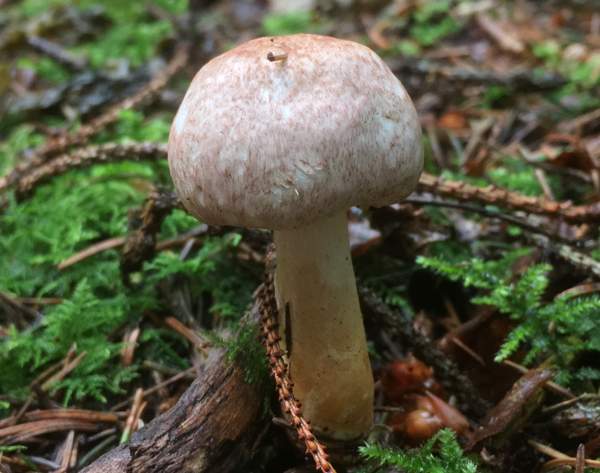
Identification guide
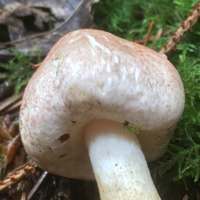 |
Cap
The cap expands to 2-7 cm in diameter. Initially near spherical or convex with inturned margins, the cap flattens at maturity. Its surface is densely covered in pink or purplish-brown radial fibrils, darkest near the centre. The cap flesh gradually turns yellow when cut, and it smells of almonds. |
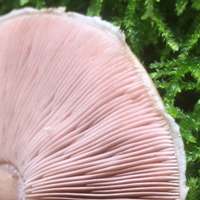 |
Gills
Free, crowded; pale pink, turning very dark purple-brown with age but retaining paler gill edges. |
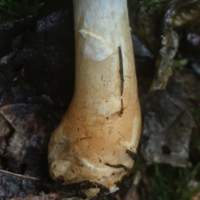 |
Stem
The stem of Agaricus dulcidulus is 2-5cm long and 0.4-0.8cm diameter with a bulbous or at least clavate base' white near the apex becoming browner towards the base. Young stems carry a superior pendent white ring which is fragile and may be only partial or absent in mature specimens. The cut stem flesh turns yellow, often with an orange tinge; it smells of almonds. |
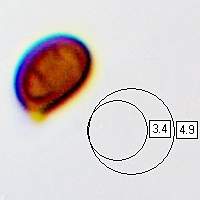 |
Spores
Ellipsoidal, smooth, 4.5-6.0 x 3.5-4.0μm; inamyloid.
Spore print
Dark purple-brown. |
Odour/taste |
Smell and taste of almonds. |
Habitat & Ecological role |
Saprobic, in deciduous woodland or on woodland edges. |
Season |
July to November in Britain and Ireland. |
Similar species |
Agaricus augustus also smells of almonds but it is a much larger mushroom and is found with conifers. |
Culinary Notes
Although reported to be edible, due to its small size and uncommon occurrence the Rosy Wood Mushroom is not considered to be of significant culinary value.
Reference Sources
Fascinated by Fungi, 2nd Edition, Pat O'Reilly 2016, reprinted by Coch-y-bonddu Books in 2022.
British Mycological Society, English Names for Fungi
The genus Agaricus in Britain, 3rd Edition, self-published, Geoffrey Kibby 2011.
Funga Nordica: 2nd edition 2012. Edited by Knudsen, H. & Vesterholt, J. ISBN 9788798396130
Dictionary of the Fungi; Paul M. Kirk, Paul F. Cannon, David W. Minter and J. A. Stalpers; CABI, 2008
Taxonomic history and synonym information on these pages is drawn from many sources but in particular from the British Mycological Society's GB Checklist of Fungi.
Acknowledgements
This page includes pictures kindly contributed by Simon Harding.
Top of page...
Fascinated by Fungi. Back by popular demand, Pat O'Reilly's best-selling 450-page hardback book is available now. The latest second edition was republished with a sparkling new cover design in September 2022 by Coch-y-Bonddu Books. Full details and copies are available from the publisher's online bookshop...